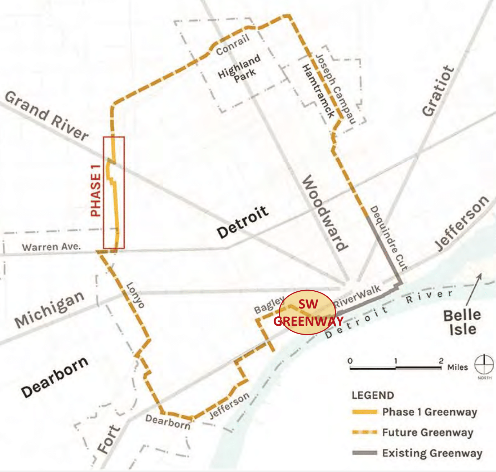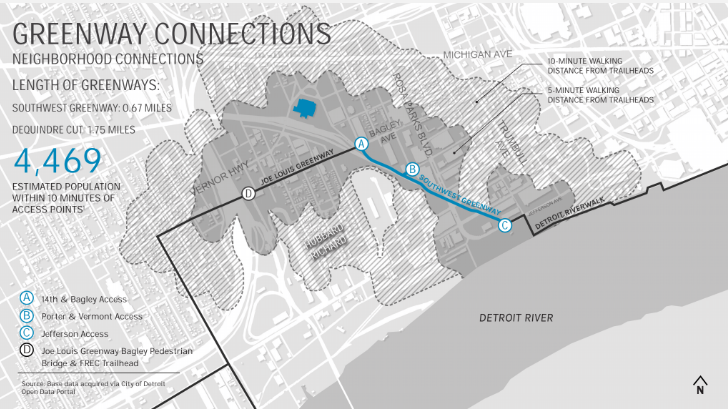Getting around Detroit by bike or on foot has improved over the last five years, and new additions to the greenway system will start to take shape this year. We recently talked to Todd Scott of the Detroit Greenways Coalition about two of the bigger projects: the Joe Louis Greenway and the May Creek, or Southwest Greenway.
The Joe Louis Greenway has been in the works for years, and eventually will have 27 miles of bike infrastructure through Detroit, Hamtramck, Highland Park, and Dearborn. The first phase of the project will start this spring, and Scott says it’s “Taking things to another level from the Dequindre Cut with separated paths for biking and walking or jogging.” And while the Dequindre Cut is below grade and somewhat separate from Eastern Market, with limited entryways, the next phases will go through neighborhoods at street-level, fully connecting the neighborhoods.

The first phase will run three miles from Warren Avenue to Fullerton on Detroit’s west side. Most will be a separate path in the neighborhood, with a small portion on-street, with protected bike lanes, on Oakman. Construction should start in June.
The May Creek, or Southwest Greenway will be under a mile long, but will add an important connection for the surrounding neighborhoods. It will run from the upcoming Ralph C. Wilson Centennial Park into Corktown, with the end at Porter and 14th, near Ford’s Corktown campus. This path will run under Fort Street, Lafayette, and Rosa Parks Boulevard, then up to street-level. The path will have lighting, signage, bike repair and racks, and seating. Construction on this path should start in July and open in May 2022.

During a recent community meeting with the Detroit Riverfront Conservancy, a commenter noted that the photos of the future trail now look like the before photos from the Dequindre Cut. It might be worth it and take some before pictures.
Not only do these greenways make it safer for cyclists and pedestrians, says Scott, but they help the surrounding community. “These trails will help revitalize the neighborhoods with added park space for residents. In a 15-minute neighborhood, people can walk and bike to local businesses.” He adds that the trail could bring more investments to the area and improve local retail strips.
There are ways for the community to get involved with greenway planning. The Streets for People initiative is currently underway through the Department of Public Works; the program is developing "a transportation plan with a singular focus — to make it easier and safer for all Detroiters to move around the city." Community members can attend virtual meetings and/or add to the map where improvements are needed.
Greenways will also be part of the next parks master plan in the city. Meetings will start to take place this summer.
Park and greenway use has increased this past year, and Scott is curious to see what happens when we go back to a more 'normal' way of life. "People are discovering the mental, physical, and social benefits of walking and biking. It will be interesting to see how people stick with it or go back to older ways. This year has affected transportation patterns and how people are getting to work. Roads have less traffic and it could change how we distribute road space."





